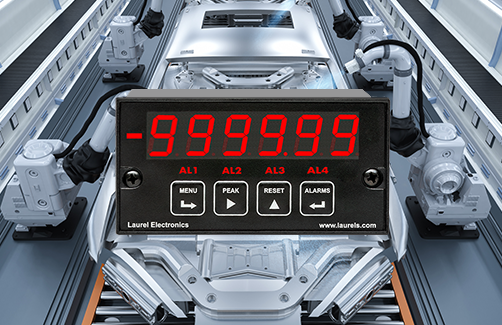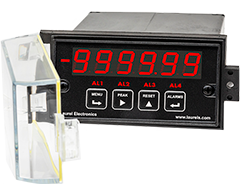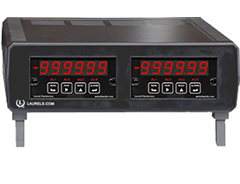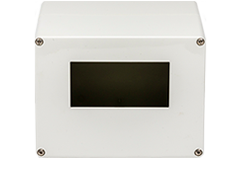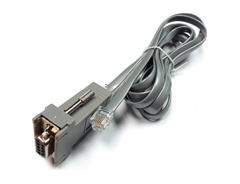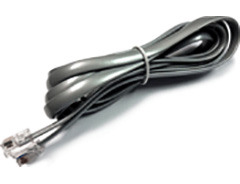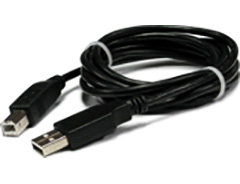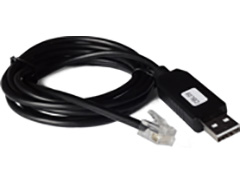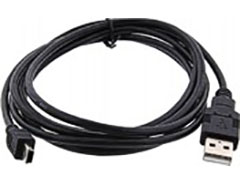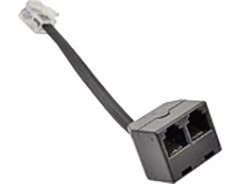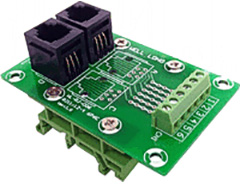Features
- Two independently field-scalable channels A & B for frequency, rate or total
- Inputs from NPN or PNP proximity switches, contact closures, digital logic, magnetic pickups down to 12 mV, or AC inputs up to 250 Vac
- Frequencies from 0.005 Hz to 1 MHz
- Line frequency measurement to 60.0000 in a few line cycles
- Digital span adjustment: 0 to ±999,999; zero adjustment: -999,999 to +999,999
- Front panel scalable: 0 to ±999,999 for use with current shunts
- 1/8 DIN size with bright red or green 0.56" (14.2mm), high LED digits
- Transducer excitation output, 5, 10, 12, or 24 Vdc (isolated)
- Power 85-264 Vac / 90-300 Vdc or 10-48 Vdc / 12-32 Vac (isolated)
- Operating temperature from -40°C to 70°C (-40°F to 158°F)
- Wide choice of Plug-in-Play options:
- 2 or 4 relays, mechanical or solid state, for alarm or control (isolated)
- 1 or 2 Analog output, 4-20 mA, 0-20 mA, 0-10V, or -10V to +10V (isolated)
- Communications: Ethernet, WiFi, USB, RS232, RS485 (isolated)
- Extended DPM includes Rate and total simultaneously, custom curve
linearization, arithmetic functions A+B, A-B, AxB, A/B, A/B-1 (draw)
The Laureate™ 1/8 DIN Digital Panel Meters for dual-channel frequency, rate and period meter
is a standard operating mode of the Laureate counter with the FR signal conditioner board. It can display frequency from 0.005 Hz to 1 MHz, rate in engineering units, and period (inverse of frequency). The normal displayed value can range up to 999,999 counts. Above that level, the display will flash and go into four-digit XXXXEX scientific notation. Each channel (A or B) may be independently scaled for frequency, rate or period. The displayed channel is selected via a front panel pushbutton. Examples of applications are the accurate display of AC line frequency, RPM, speed from proximity switch inputs, and flow from turbine flow meter inputs.- Fast, high resolution measurements. The Laureate counter determines frequency by timing an integral number of periods over a specified gate time, and then taking the inverse of period. Rate is obtained by multiplying the input by a scale factor. The inverse period approach allows greater accuracy and faster update times than conventional meters which count signal pulses over a time interval. AC line frequency may be accurately measured to 50.0000 or 60.0000 Hz in a few line cycles. 1000 Hz signals may be measured to 0.01 Hz resolution at up to 25 readings per second. Fast response is ideal for alarm and control applications.
- For noise reduction, a count by 10 or 100 feature with rounding is selectable. Variations in the displayed reading can also be reduced by selecting a longer gate time. An adaptive digital filter is selectable to reduce variations due to noise while rapidly responding to actual changes in the signal.
Laureate Digital Panel Meters are easily programmed with Laurel’s free Instrument Setup Software, downloadable from our website and compatible with Windows PCs, requiring a data interface board for setup.
All signal conditioner board ranges are factory-calibrated, with calibration factors for each range securely stored in an onboard EEPROM. These factors can be scaled via software to accommodate external shunts, enabling field replacement of signal conditioner boards without necessitating recalibration of the associated digital panel meters. For optimal accuracy, factory recalibration is recommended annually. All Laurel Electronics instruments undergo factory calibration using the industry-leading Fluke calibrators, which are recalibrated yearly and certified traceable to national standards, ensuring the highest level of precision and reliability.
An Optional Extended Counter Version Provides Capabilities Beyond Those of the Standard Counter:
- Rate and total simultaneously. Channel A can display total while Channel B displays rate. The selection of A or B for display is via a front panel pushbutton. This mode is ideal for flow applications.
- Up/down counting. Channel A can serve as an up/down counter, where the count direction is dynamically changed by applying a signal to Channel B. For instance, Channel A can count and scale pulses from a turbine flow meter, while Channel B inputs the direction of flow. This allows total volume to be tracked in case of reversible flow.
- Totalizing with external inhibit. Totalizing by Channel A can be temporarily inhibited by applying a signal to Channel B. For instance, 60 Hz AC pulses can be counted by Channel A and be scaled to display elapsed hours. A signal can be applied to Channel B to start or stop pulse counting when a process is in operation.
- Custom curve linearization. Exceptionally accurate custom curve linearization is achievable, for example to linearize the low end of turbine flow meters. For setup, up to 180 data points can be input into a spreadsheet or text file by the user. The computer then calculates spline fit segments, which are downloaded into the meter via RS232. The linearized rate can then be totalized by the Extended counter.
- Arithmetic functions. The Extended counter makes arithmetic functions available, namely A+B, A-B, AxB, A/B and A/B-1. These solve many applications. For instance, A+B allows two input flows to be summed for total volume, while A-B allows outflow to be subtracted from inflow for net volume. A/B allows the mixing of ingredients in a specified ratio. By monitoring and alarming the A/B volume ratio, ingredient B can be added to A until the proper ratio is achieved.
The FR dual-channel signal conditioner accepts inputs from proximity switches with a PNP or NPN output, TTL or CMOS logic, magnetic pickups, contact closures, low-level outputs from turbine flow meters down to 12 mV, and high-level AC line inputs up to 250 Vac. A built-in (isolated) 5, 10, 12, or 24 Vdc excitation supply can power proximity switches and other sensors, thus eliminating the need for an external power supply.
- An unfiltered selection provides true peak and valley readings and aids in control applications.
- A batch average filter selection averages each 16 conversions.
- An adaptive moving average filter selection provides a choice of 8 time constants from 80 ms to 9.6 seconds. When a significant change in signal level occurs, the filter adapts by briefly switching to the shortest time to follow the change, then reverts back to its selected time constant. An Auto setting selects the time constant selection based on signal noise.
Peak and valley values are automatically captured. These may be displayed via a front panel pushbutton command or control signal at the rear connector, or be transmitted as serial data.
Two rear panel control Inputs (CMOS/TTL levels, logic 0 = tied to digital ground, logic 1 = open) or dry contacts that can be set to control / activate 14 meter commands.
An (isolated) 5, 10, 12, or 24 Vdc excitation output is standard to power transducers or two-wire transmitters. Ratiometric operation, which automatically compensates for changes in the applied excitation, is jumper selectable for applications, such as bridges, where the signal to be measured is proportional to the excitation level.
Modular Design for Maximum Flexibility at Minimum Cost
All boards are isolated from meter and power grounds. Optional Plug-in-Play boards for communications and control include Ethernet, WiFi, serial communication boards, dual or quad relay boards, and an analog output board. Laureates may be powered from 85-264 Vac or optionally from 12-32 Vac or 10-48 Vdc. The display is available with bright red or green 0.56" (14.2mm) high LED digits. The 1/8 DIN case meets NEMA 4X (IP65) specifications from the front when panel mounted. Any setup functions and front panel keys can be locked out for simplified usage and security. A built-in 5, 10, 12, or 24 Vdc excitation supply can power transducers, eliminating the need for an external power supply. All power and signal connections are via UL / VDE / CSA rated screw clamp plugs.
The Laureate™ Series features modular design with up to 7 isolated plug-in boards, applicable to all Laureate 1/8 DIN Digital Panel Meters.

Modular Hardware
The design of the Laureate™ Series is modular for maximum flexibility at minimum cost. All boards are isolated from meter and power grounds. The base configuration for a panel meter or counter consists of a main module (with computer and plug-in display boards), a power supply board, and a signal conditioner board. Optional plug-in-play boards include an isolated setpoint controller board, an isolated analog output board, and an isolated digital interface board. Modular design and a choice of plug-in options allow the Laureate to be customized for a broad range of applications from simple monitoring to control and computer interface. There can be up to five plug-in boards in a 1/8 DIN Laureate.

Connecting Laureate Digital Panel Meters to a Local Area Network (LAN)
Up to 30 Laureate Digital Panel Meters and/or LT Transmitters can be configured for RS485 and daisy-chained to an LT Transmitter using Laurel’s High Speed Ethernet-to-RS485 converter board for seamless LAN integration. Alternatively, Laurel LTE series Ethernet transmitters can connect directly to a LAN via an Ethernet cable. Setup for both configurations is streamlined using Laurel’s free Instrument Setup Software, which simplifies node discovery and transmitter configuration.
Flexible Communication Options for Digital Panel Meters
Laureate Digital Panel Meters can be equipped with Laurel communication boards to support various interfaces and protocols. These include serial interfaces with ASCII or Modbus RTU protocols, and Ethernet interfaces with web access, ASCII, or Modbus TCP/IP protocols, ensuring versatile connectivity for your commercial applications.

| Display | |
|---|---|
| Readout | 6 LED digits, 7-segment, 14.2 mm (.56"), red or green. |
| Display Range | -999,999 to +999,999, XXXXEX notation beyond 999,999 |
| Zero Adjust | -999,999 to +999,999 |
| Span Adjust | 0 to ±999,999 |
| Indicators | Four LED lamps |
| Inputs | |
| Types | AC, pulses from NPN, PNP transistors, contact closures, magnetic pickups. |
| Signal Ground | Common ground for channels A & B |
| Channel A Freq. | 0.005 Hz to 1 MHz |
| Channel B Freq. | 0.005 Hz to 250 kHz |
| Minimum Signal | Nine ranges from (-12 to +12 mV) to (+1.25 to +2.1V). |
| Maximum Signal | 250 Vac |
| Noise Filter | 1 MHz, 30 kHz, 250 Hz (selectable) |
| Contact Debounce | 0, 3, 50 ms (selectable) |
| Recalibration: All ranges are calibrated at the factory. Recalibration is recommended every 12 months. | |
| Update Rate | |
| Freq. Technique | Inverse period |
| Conversion Time | Gate time + 30 ms+ 0-2 signal periods |
| Gate Time | Selectable 10 ms to 199.99 s |
| Time Before Zero Out | Selectable 10 ms to 199.99 s |
| Accuracy | |
| Time Base | Crystal calibrated to ±2 ppm |
| Span tempco | ± 1 ppm/°C (typ) |
| Long-term Drift | ± 5 ppm/year |
| Power Supply Boards (one required) | |
| Voltage, standard | 85-264 Vac or 90-300 Vdc |
| Voltage, optional | 12-32 Vac or 10-48 Vdc |
| Frequency | DC or 47-63 Hz |
| Power consumption (typical, base meter) | 1.2W @ 120 Vac, 1.5W @ 240 Vac, 1.3W @ 10 Vdc, 1.4W @ 20 Vdc, 1.55W @ 30 Vdc, 1.8W @ 40 Vdc, 2.15W @ 48 Vdc |
| Power Isolation | 250V rms working, 2.3 kV rms per 1 min test |
| Excitation Output (standard) | |
| 5 Vdc | 5 Vdc ± 5%, 100 mA (jumper selectable) |
| 10 Vdc | 10 Vdc ± 5%, 120 mA (jumper selectable) |
| 12 Vdc | 12 Vdc ± 5%, 100 mA (jumper selectable) |
| 24 Vdc | 24 Vdc ± 5%, 50 mA (jumper selectable) |
| Output Isolation | 50 Vdc from signal ground |
| Analog Output Boards (one optional) | |
| Output levels | 4-20 mA, 0-20 mA, 0-10V, -10 to +10V (single-output option) |
| 4-20 mA, 0-20 mA, 0-10V (dual-output option) | |
| Current compliance | 2 mA at 10V ( > 5 kΩ load) |
| Voltage compliance | 12V at 20 mA (< 600 Ω load) |
| Scaling | Zero and full scale adjustable from -99999 to +99999 |
| Resolution | 16 bits (0.0015% of full scale) |
| Isolation | 250V rms working, 2.3 kV rms per 1 min test |
| (dual analog outputs share the same ground) | |
| Relay Output Boards (one optional) | |
| Dual magnetic relays | 2 Form C, 10A max, 440Vac or 125Vdc max, 2500VA or 300W |
| Quad magnetic relays | 4 Form A (NO), 10A max, 440Vac or 125Vdc max, 2500VA or 300W |
| Dual solid state relays | 2 Form A (NO), AC or DC, 0V - 400V, 120Ma, 35Ohms (max at On-State) |
| Quad solid state relays | 4 Form A (NO), AC or DC, 0V - 400V, 120Ma, 35Ohms (max at On-State) |
| Relay commons | Isolated commons for dual relays or each pair of quad relays |
| Relay isolation | 250V rms working, 2.3 kV rms per 1 minute test |
| Relay latching modes | Latching or non-latching |
| Relay active modes | Active on or off, active high or low |
| Hysteresis modes | QA passband mode, split hysteresis, span hysteresis |
| Serial Data I/O (optional) | |
| Board selections | RS232, RS485 with dual RJ11 connectors, RS485 with dual RJ45 connectors, USB, Ethernet, USB-to-RS485 gateway, Ethernet-to-RS485 gateway, WiFi with built-in antenna plus USB & RS485, WiFi with external antenna plus USB & RS485 |
| Protocols | Laurel Custom ASCII (serial), Modbus RTU (serial), Modbus TCP (Ethernet or WiFi) |
| Digital addresses | 247 (Modbus), 31 (Laurel ASCII), |
| Isolation | 250V rms working, 2.3 kV rms per 1 min test |
| Environmental | |
| Operating temperature | -40°C to 70°C (-40°F to 158°F) |
| Storage temperature. | -40°C to 85°C (-40°F to 185°F) |
| Relative humidity | 95% at 40°C, non-condensing |
| Protection | NEMA-4X (IP-65) when panel mounted |
| Electrical Connections | |
 |
|
| Mechanical | |
| Enclosure | 1/8 DIN, high impact plastic, UL 94V-0, color: black |
| Mounting | 1/8 DIN panel cutout required: 3.622" x 1.772" (92 mm x 45 mm). |
| Dimensions | 4.68" x 2.45" x 5.64" (119 mm x 62 mm x 143 mm) (W x H x D) |
| Maximum panel thickness | 4.5 mm (0.18") |
| Tightening Torque - Connectors | Screw terminal connectors: 5 lb-in (0.56 Nm) |
| Tightening Torque - Pawls | Digital Panel Meter Case Pawls: 5 lb-in (0.56 Nm) |
| Weight of base meter | 210 g (7.4 oz) typical (DPM, counter, timer, 6-digit remote display) |
| Weight of option boards | 30 g (1.0 oz) typical per board (analog output, relay output, communications) |
| General | |
| Programming Methods | Four front panel buttons or via Laurel's free Instrument Setup Software, which runs on a PC under MS Windows. |
| Security | Lockout options include using the front panel buttons, the free Instrument Setup Software, or a hardware jumper. |
| Warranty | 3 years parts & labor |
| Recalibration: All ranges are calibrated at the factory. Recalibration is recommended every 12 months. | |
Free Instrument Setup Software for Series 2 Laureates
Free Downloadable Windows-based Instrument Setup (IS) software (Data Interface Board Required) for use with our programmable Digital Panel Meters, Scale Meters, Counters, Timers, Remote Displays, and Transmitters, are an easy method to set up Laureate 1/8 DIN digital panel meters, counters, timers, remote displays, and DIN-rail transmitters, as explained in the Instrument Setup Software Manual. Laureate 1/8 DIN instruments can also be set up from the front panel, as explained in their respective Owners Manuals. Instrument Setup software is of benefit whether or not the PC is connected to the instrument.
- When the PC is connected to the instrument, Instrument Setup software can retrieve the setup file from the instrument or open a default setup file or previously saved setup file from disk View Setup, then provides graphical user interface (GUI) screens with pull-down menus applicable to input, display, scaling, filtering, alarms, communications, analog output, and front panel lockouts. Fields that are not applicable to the instrument as configured are either left out or grayed out. Clicking on any item will bring up a detailed Help screen for that item. After editing, the setup file can be downloaded, uploaded to the instrument, or saved to a disk. The same setup file can then be downloaded into multiple instruments.
- When the PC is not connected to the instrument, the above GUI screens can be used to set up a virtual instrument. The setup file can then be saved to disk. Switching toView Menu then brings up a screen with the required front panel programming steps. This view can be printed out for use at the instrument site and to serve as a hard copy record.
Download Free Instrument Setup Software
Installation
Set User Account Control (UAC) of MS Windows to "Never notifiy me" so that Instrument Setup Software can create directories. The UAC change screen can be reached as follows:
- Under Windows 7, click on the Windows Start button in the lower left of the desktop and enter "UAC" in the search field.
- Under Windows 8, navigate to Control Panel, then to the "User Accounts and Family Safety" section, and click on "Change User Account Control Settings."
- Under Windows 10, click on the Windows Start button in the lower left of the desktop, then on "Settings", and enter "UAC" in the search field.
- Reboot your computer for the changed UAC setting to take effect.

RJ11-to-DB9 cable with rear view of DB9 connector to PC

RS232 cable, meter to PC, P/N CBL01
Laureate 1/8 DIN Laureate instruments must be equipped with a serial communications board and be connected to the computer via a serial communications cable. The connection can be via RS232, RS485, USB or Ethernet. Following setup, the serial communications board may be removed from the instrument if desired. The wiring of the RS232 cable is illustrated above with end views of the two connectors.
Laureate LT Series transmitters come standard with a 3-wire serial interface, which can be jumpered for RS232 or RS485.
Laureate LTE Series transmitters come standard with an Ethernet interface.
Meter Setup Screens
Click on any of the reduced screens below for a full-size screen view, then click on the Back button of your browser to return to this page. The screens examples below are for a fully-loaded Series 2 Digital Panel Meter (DPM), which is connected to the PC via RS232. If the meter is a Series 1 meter (pre-2007), this is sensed by the software, and somewhat different screens are brought up. Please see Series 1 setup screens.











Meter Setup Utilities




From the Main Menu, click on Readings if your PC is connected to the meter. A pull-down menu then offers three choices: List, Plot and Graph.
- List presents the latest readings in a 20-row by 10-column table. Press Pause at any time to freeze the display. This is one method to capture peak readings.
- Plot generates a plot of readings vs. time in seconds. It effectively turns the DPM-PC combination into a printing digital oscilloscope.

- Graph generates a histogram where the horizontal axis is the reading and the vertical axis is the number of occurrences of readings. The display continually resizes itself as the number of readings increases.



Laureate™ 1/8 DIN Case For Laureate Digital Panel Meters, Counters, Timers & Remote Displays
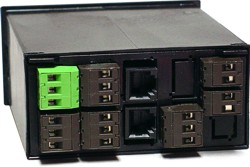
Key Features
- Meets 1/8 DIN Standard.
- Installs from front of panel.
- Short depth behind the panel: only 4" (102 mm) plus connectors.
- Understated 0.157" (4 mm) thick bezel.
- Meets NEMA 4X (IP-65) for high-pressure wawshdon when panel mounted.
- Screw clamps connectors meet VDE / IEC / UL / CSA safety standards.
- Rugged GE Lexan® housing material.
- Safety certified per EN 61010-1.
Dimensions
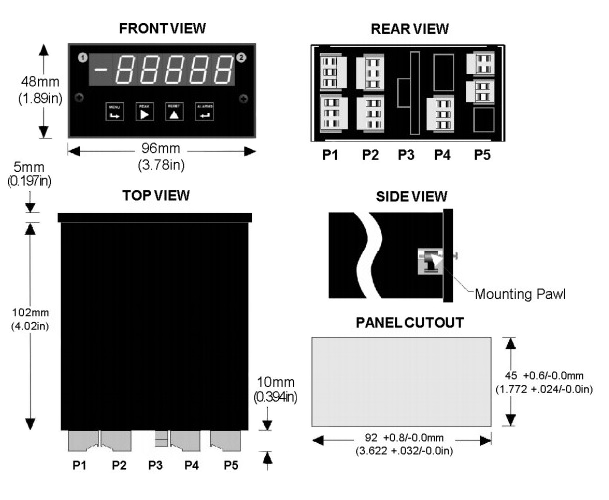
Maximum panel thickness: 4.5 mm (0.18")
Weight of base meter: 210 g (7.4 oz) typical (DPM, counter, timer, 6-digit remote display)
Weight of option boards: 30 g (1.0 oz) typical per board (analog output, relay output, communications)
Tightening Torque - Connectors: Screw terminal connectors: 5 lb-in (0.56 Nm)
Tightening Torque - Pawls: Digital Panel Meter Case Pawls: 5 lb-in (0.56 Nm)
Dimensioned CAD assembly drawings in EPRT, STEP, x_t. dwg, pdf file formats: Laureate-meter-case.zip (zipping prevents browser from opening CAD files as text files).
Panel Mounting
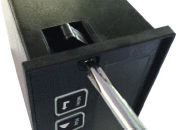 Slide the meter into a 45 x 92 mm 1/8 DIN panel cutout. Ensure that the provided gasket is in place between the front of the panel and the back of the meter bezel.
The meter is secured by two pawls, each held by a screw, as illustrated. Turning each screw counterclockwise extends the pawl outward from the case and behind the panel. Turning each screw clockwise further tightens it against the panel to secure the meter.
Slide the meter into a 45 x 92 mm 1/8 DIN panel cutout. Ensure that the provided gasket is in place between the front of the panel and the back of the meter bezel.
The meter is secured by two pawls, each held by a screw, as illustrated. Turning each screw counterclockwise extends the pawl outward from the case and behind the panel. Turning each screw clockwise further tightens it against the panel to secure the meter.
Turning each screw counterclockwise loosens the pawl and retracts it into its well. This position allows installed meter to be removed from their panel, or new meters to be installed in a panel. Do not remove the screws from their pawls. Doing so would cause the screw and pawl to fall off and likely get lost. Do not overtighten so as not to damage the plastic parts.
| AC Line Frequency | |
|---|---|
 |
The Laureate will accept line voltages up to 250 Vac and display line frequency to 6-digit accuracy (50.0000 or 60.0000) in a few line cycles. Fast low frequency response is achieved by timing the period and taking its inverse. |
| RPM and Speed | |
 |
The Laureate can sense the low-level signals from magnetic pickups or the NPN or PNP transistor output of active sensors. These can be powered directly by the meter. Display in RPM or units of speed is achieved by mathematically scaling the meter. |
| Flow Rate and Simultaneous Total | |
 |
The Laureate is compatible with all flow meters which generate pulses at a frequency proportional to flow rate. The Extended version can display scaled rate or total for the same input at the push of a button, and alarm from both the rate and total. The Extended version can also linearize flow transducers so as to extend their dynamic range. |
| Arithmetic Combinations of Two Channels | |
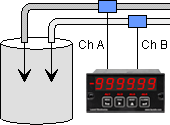 |
The Extended Laureate offers A+B, A-B and A/B arithmetic functions. A+B allows two input flows to be summed for total flow, while A-B allows outflow to be subtracted from inflow for net flow. Flow ratios aid in the proper mixing of ingredients |
| Custom Curve Linearization | |
 |
The Extended Laureate can linearize the output turbine flow meters, which tend to be nonlinear on the low end. Linearizing improves the dynamic range and accuracy of turbine flow meters. |
| System-level Capabilities | |
| The Laureate dual channel rate meter can independently scale, display and alarm two pulse input channels. All signal or alarm data can further be transmitted via RS232 or RS485, including peak readings and arithmetic combinations of the two rates. The displayed rates can also be transmitted as an isolated 4-20 mA or 0-10V analog output. | 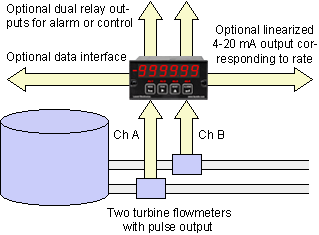 |
IPC
Splashproof Cover
CBL01
RS232 Cable for Meters
CBL02
USB-to-RS232 Adapter Cable
CBL04
RS232 Cable for LT Transmitters
CBL05
USB Data Cable for Meters
CBL06
USB-to-RS485 Adapter Cable
CBL07
USB Programming & Data Cable
CBL08
RS485 Splitter Cable
BKBD
RS485 RJ11 Terminal Block Adapter
What are 1/8 DIN Digital Panel Meters for Frequency, Rate, and Period?
1/8 DIN digital panel meters are a versatile and precise instrument used in various industrial and engineering applications to measure and display frequency, rate, and period. The term "1/8 DIN" refers to the physical size of the panel meter, conforming to a standardized dimension, making it easy to integrate into control panels and enclosures. This article delves into the key aspects of 1/8 DIN digital panel meters, focusing on their application in measuring frequency, rate, and period.
Understanding the Basics: DIN Standards
DIN stands for "Deutsches Institut für Normung," which is the German Institute for Standardization. The DIN standards are used globally to ensure compatibility and uniformity of components in industrial and electronic equipment. The "1/8 DIN" specification indicates the size of digital panel meters, with dimensions typically around 96 x 48 mm (3.78 x 1.89 inches). This compact size makes it a popular choice for applications where space is limited.
Applications of 1/8 DIN Digital Panel Meters
1/8 DIN digital panel meters are used in a wide range of applications, from simple monitoring tasks to complex process control systems. They are particularly valuable in industries such as:
- Manufacturing: Monitoring and controlling machine speeds, motor frequencies, and production rates.
- Power Generation: Measuring the frequency of electrical signals in power plants.
- Automation: Tracking process rates and cycle times in automated systems.
- Research and Development: Recording frequencies and periods in experimental setups.
Key Functions: Frequency, Rate, and Period Measurement
1/8 DIN digital panel meters are designed for frequency, rate, and period measurement performs three critical functions:
-
Frequency Measurement:
Frequency is the number of occurrences of a repeating event per unit of time, typically measured in Hertz (Hz). For example, in electrical engineering, frequency refers to the number of cycles per second of an alternating current (AC) signal. 1/8 DIN digital panel meters can accurately measure and display the frequency of these signals, which is crucial for maintaining the stability and efficiency of electrical systems. -
Rate Measurement:
Rate measurement refers to the speed at which a particular process occurs. In industrial settings, this could mean the speed of conveyor belts, the rate of fluid flow, or the rate of production in a manufacturing process. The digital panel meters convert the input signal into a rate reading, allowing operators to monitor and adjust processes in real-time. -
Period Measurement:
The period is the duration of one cycle in a repeating event. For example, if a machine completes one cycle every two seconds, the period is two seconds. Period measurement is the inverse of frequency measurement and is particularly useful in applications where timing is critical, such as in timing analysis or synchronization tasks.
Features and Benefits of 1/8 DIN Digital Panel Meters
1/8 DIN digital panel meters offer several features and benefits that make them ideal for industrial use:
-
Compact Size: The standardized 1/8 DIN size ensures that the meter can be easily integrated into existing panels and systems without requiring significant modifications.
-
High Accuracy and Precision: These digital panel meters are designed to provide accurate and reliable measurements, which are essential in critical applications where precision is paramount.
-
Easy-to-Read Display: Most 1/8 DIN digital panel meters come with bright LED or LCD displays that provide clear, real-time readings, making it easy for operators to monitor the system status at a glance.
-
Versatile Input Options: They can accept a variety of input signals, including analog and digital signals, making them adaptable to different types of sensors and transducers.
-
Configurable Outputs: Many models offer configurable output options, such as alarms or analog outputs, which can be used to trigger other processes or alert operators to out-of-range conditions.
-
Durability: Designed to withstand harsh industrial environments, these meters are typically rugged and durable, ensuring long-term reliability.
Conclusion
1/8 DIN digital panel meters for frequency, rate, and period is a critical tool in many industrial and engineering applications. Its compact size, combined with its ability to provide accurate and real-time measurements, makes it an invaluable asset for monitoring and controlling processes. Whether used in manufacturing, power generation, automation, or research, these panel meters offer the precision and reliability needed to maintain optimal system performance.
Where are 1/8 DIN Digital Panel Meters for Frequency, Rate & Period Used?
1/8 DIN digital panel meters for frequency, rate, and period measurement is a versatile instrument widely used in various industries and applications. These meters provide precise measurements of frequency, rate, and period, which are critical in many processes. Below, we'll explore some of the primary areas where these devices are commonly employed.
1. Industrial Automation and Process Control
In industrial automation, controlling and monitoring the speed, frequency, and timing of various processes are essential for maintaining efficiency and safety. 1/8 DIN digital panel meters are used to monitor the frequency of electrical signals, the rate of motor rotations, or the timing between events in automated processes.
For example, in a manufacturing plant, these meters can monitor conveyor belt speeds, ensuring that materials are moved at the correct rate to prevent bottlenecks or overloading. In packaging lines, they help ensure that products are processed and packaged at consistent speeds, improving overall efficiency.
2. Power Generation and Distribution
Power plants and electrical substations rely heavily on accurate frequency measurement to ensure the stability of the power grid. The 1/8 DIN digital panel meters are often used to monitor the frequency of alternating current (AC) signals, which is crucial in maintaining the synchronization of generators and the grid.
A stable frequency ensures that electrical equipment operates correctly and safely. Any deviation from the standard frequency (e.g., 50 Hz or 60 Hz) can indicate issues such as generator malfunctions or grid instability, which require immediate attention.
3. Telecommunications
In telecommunications, accurate frequency measurement is critical for the proper functioning of communication systems. The 1/8 DIN digital panel meters are used to measure and monitor the frequency of signals in communication networks, ensuring that data transmission is reliable and free from interference.
For instance, in radio broadcasting, these meters help in maintaining the correct frequency of transmitted signals, preventing overlaps or distortions in the broadcast. In cellular networks, they ensure that communication signals are transmitted and received at the correct frequencies, which is vital for maintaining clear and stable connections.
4. Automotive Testing and Diagnostics
The automotive industry uses 1/8 DIN digital panel meters to test and diagnose various aspects of vehicle performance. These meters are used to measure the frequency and rate of signals in engines, transmissions, and other critical systems.
For example, during engine testing, these meters can monitor the ignition frequency, ensuring that the engine fires at the correct intervals for optimal performance. They are also used to measure the rate of sensor signals, such as those from wheel speed sensors or fuel injectors, providing valuable data for diagnostics and tuning.
5. Laboratory and Research Applications
In laboratories and research facilities, accurate measurements of frequency, rate, and period are often required for experiments and data collection. 1/8 DIN digital panel meters are a reliable tool for these applications, providing precise and consistent measurements.
Researchers might use these meters to measure the frequency of oscillating signals in electronic circuits or to monitor the timing of events in a controlled experiment. Their compact size and versatility make them a popular choice for bench-top setups where space is limited.
6. HVAC and Environmental Control Systems
Heating, ventilation, and air conditioning (HVAC) systems often require precise control of fan speeds, air flow rates, and other parameters to maintain desired environmental conditions. 1/8 DIN digital panel meters can be used to monitor and control these parameters, ensuring that the HVAC system operates efficiently.
For example, these meters can measure the frequency of fan motor signals, helping to regulate the speed of the fans based on the temperature or air quality requirements. This ensures that the environment remains comfortable and energy-efficient.
Conclusion
1/8 DIN digital panel meters for frequency, rate, and period measurement is a versatile and essential tool across a wide range of industries. Its ability to provide accurate and reliable measurements makes it invaluable for ensuring the smooth operation of industrial processes, power generation, telecommunications, automotive systems, and more. Whether used in a manufacturing plant, a power station, or a research lab, this compact and precise instrument plays a critical role in modern technology and industry.
Less Information.








